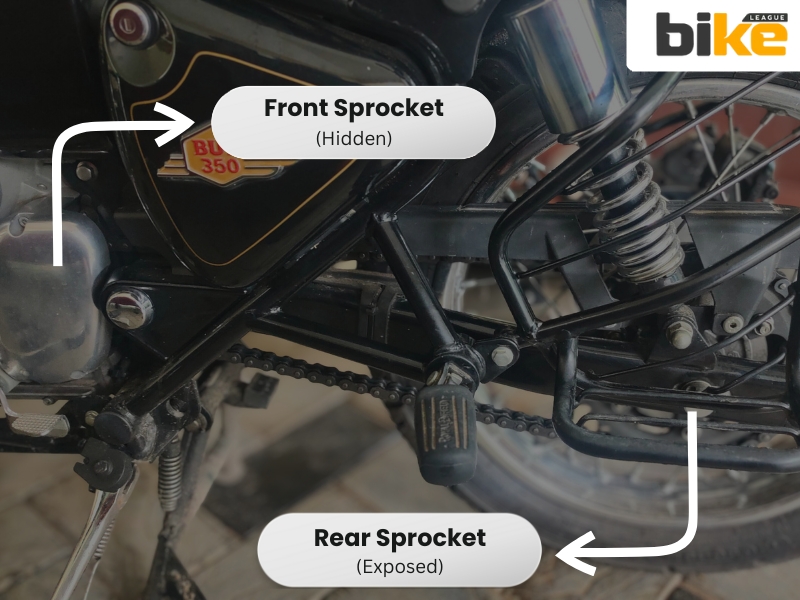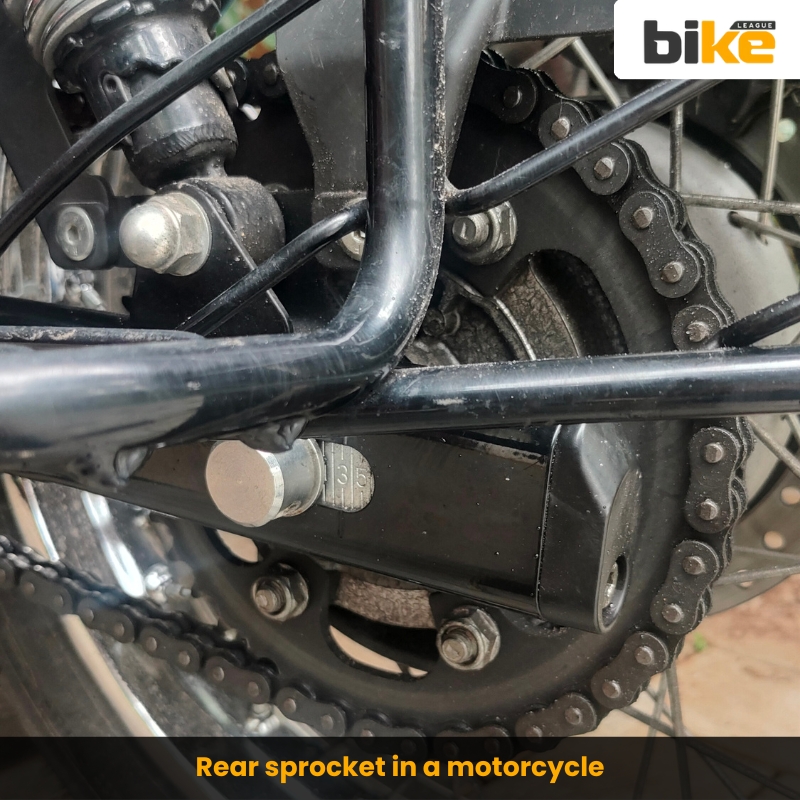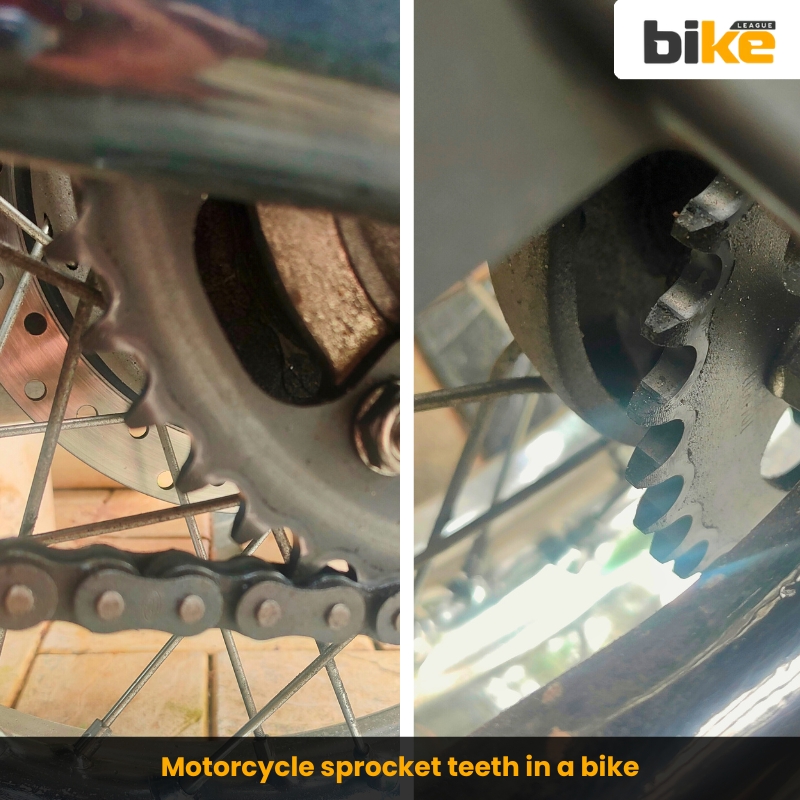
Have you heard about the term motorcycle sprocket?. Most of us are familiar with what a motorcycle chain is. Still, we have limited knowledge about motorcycle sprockets in depth. In this blog, we will delve into motorcycle sprockets, sprocket teeth, gear ratios, and more, explaining how they affect ride behaviour, mileage, power, and torque in detail.
Additionally, we will discuss how to maintain motorcycle sprockets and the signs indicating when they need to be replaced. Let’s start by examining basic terms and jargon first.
What Is a Motorcycle Sprocket?
A motorcycle sprocket is a toothed wheel that engages the drive chain (or belt) to transfer engine power to the rear wheel. Most chain‑driven motorcycles use two sprockets:
1. Front (Drive) Sprocket
Mounted on the transmission’s output (countershaft). As the engine turns the countershaft, it spins the front sprocket, which in turn pulls the chain.
2. Rear (Driven) Sprocket
Mounted on the rear wheel hub. The moving chain transfers rotational force from the front sprocket to the rear sprocket, driving the wheel and propelling the bike.
What Is Motorcycle Gear (Final‑Drive) Ratio?
Your motorcycle’s final‑drive gear ratio is the relationship between how many times the engine turns versus one turn of the rear wheel, set by the sprockets:
Gear Ratio = Front Sprocket Teeth / Rear Sprocket Teeth
1. Numerically Higher Ratio (e.g., 48 ÷ 15 = 3.20 : 1)
Engine spins 3.20 times per wheel revolution → more potent low‑end punch, quicker acceleration, but higher RPM at cruising speeds (more fuel burn on open roads).
2. Numerically Lower Ratio (e.g., 40 ÷ 16 = 2.50 : 1)
Engine spins 2.50 times per wheel revolution → lower cruising RPM (better fuel economy on highways) but less immediate acceleration and greater risk of engine “lug” at low speeds.
What is the difference between motorcycle gear ratio, transmission ratio and final drive ratio?
1. Transmission Ratio
- What it is: The ratio between the speed of the engine’s input shaft and the gearbox’s output shaft for a given gear.
- How it’s expressed: Typically as “Engine : Output” (e.g. 2.40 : 1 in 1st gear).
- Role: Determines how many times the engine must turn to spin the gearbox output once—short ratios (high numbers) give strong launch; tall ratios (numbers greater than 1) enable overdrive cruising.
2. Final‑Drive Ratio
- What it is: The ratio set by the front and rear sprockets (or belt/pulley) that connects the gearbox output to the rear wheel.
- How it’s expressed: “Rear‑teeth ÷ Front‑teeth” (e.g. 45 ÷ 15 = 3.00 : 1).
- Role: Multiplies the gearbox output turns into wheel turns—more rear teeth or fewer front teeth raises the ratio (better acceleration), fewer rear or more front teeth lowers it (taller gearing for top speed).
3. Overall (Drive) Gear Ratio
- What it is: The product of the transmission ratio and the final‑drive ratio in a particular gear.
- How it’s expressed: Overall Ratio=(Transmission Ratio in Gear N)×(Final‑Drive Ratio)
- Role: Tells you how many engine revolutions produce one rear‑wheel revolution in that gear, combining gearbox spread and sprocket choice into a single performance characteristic.
How are motorcycle sprocket teeth & gear ratio interconnected?
The teeth count on the front and rear sprockets determines the overall gear ratio:
Gear Ratio = Front Sprocket Teeth/ Rear Sprocket Teeth
1. Higher ratio (more rear teeth or fewer front teeth)
- Pros: Better acceleration, stronger low-end pull
- Cons: Lower top speed, higher engine RPM at cruising speeds
2. Lower ratio (fewer rear teeth or more front teeth)
- Pros: Higher top speed, lower cruising RPM
- Cons: Slower acceleration, reduced engine braking
Common Front & Rear Sprocket Tooth Counts in some Popular Indian Motorcycles
Below is a snapshot of stock sprocket configurations on various bikes commonly seen on Indian roads. Use these examples to get a sense of typical gearing setups and ratios:
| Motorcycle Model | Segment | Front Sprocket Teeth | Rear Sprocket Teeth | Gear Ratio |
|---|---|---|---|---|
| Royal Enfield Himalayan | Adventure | 18 | 44 | 2.44:1 |
| Royal Enfield Classic 350 | Cruiser (Heritage) | 17 | 45 | 2.65 : 1 |
| Bajaj Pulsar NS200 | Sport Naked | 15 | 42 | 2.80 : 1 |
| Yamaha R15 V4 | Sportbike | 15 | 42 | 2.80 : 1 |
| Hero Splendor Plus | Commuter | 14 | 40 | 2.86 : 1 |
| Bajaj Pulsar 150 | Sport Commuter | 14 | 41 | 2.93 : 1 |
| TVS Apache RTR 160 | Sport Commuter | 15 | 45 | 3.00 : 1 |
| KTM Duke 200 | Sport Naked | 14 | 42 | 3.00 : 1 |
| Honda CB350 | Cruiser (Retro) | 15 | 46 | 3.07 : 1 |
| Kawasaki Ninja 300 | Sportbike (Entry) | 15 | 47 | 3.13 : 1 |
Adventure Bikes (2.44 : 1)
Royal Enfield Himalayan sits at the bottom with the lowest numerical ratio (2.44 : 1), optimizing around‑town tractability, rock‑crawling and technical off‑road riding. The taller gearing reduces chain tension, smooths low‑speed power delivery, and eases fatigue in rough terrain.
Cruiser Bikes (2.65 : 1 → 3.07 : 1)
Royal Enfield Classic 350 (2.65 : 1) prioritizes relaxed highway cruising with lower RPM at speed, matching its retro‑cruiser character. The Honda CB350 (3.07 : 1), with a higher ratio, trades some top‑end calm for punchier roll‑on acceleration—befitting its “mini‑cruiser” ethos.
Commuter Bikes (2.80 : 1 → 2.93 : 1)
Mass‑market commuters like the Hero Splendor Plus (2.86 : 1) and Bajaj Pulsar 150 (2.93 : 1) land in the middle, offering a good blend of city responsiveness and reasonable highway manners. Two sport‑commuter outliers—the Bajaj Pulsar NS200 and Yamaha R15 V4—share a 2.80 : 1 ratio, skewing slightly toward quicker roll‑on in urban traffic.
Sports Bikes (3.00 : 1 → 3.13 : 1)
TVS Apache RTR 160 and KTM Duke 200 both run a 3.00 : 1 ratio, delivering crisp low‑end response for aggressive street riding. At the top, the Kawasaki Ninja 300’s 3.13 : 1 gearing maximizes acceleration and on‑throttle response—ideal for track‑style riding, but with higher cruising RPM.
How to Choose the Correct Motorcycle Sprocket Setup?
Motorcycle sprocket setup affects the overall behaviour and ride type of the motorcycle and here’s how it varies for each type
- Off‑Roaders & Adventure Riders should lean toward lower numerical ratios (like the Himalayan) for torque and control.
- Cruiser & Touring riders benefit from ratios under ~2.7 : 1 to keep RPMs—and rider fatigue—down on long straights.
- Daily Commuters generally do well around 2.8–2.9 : 1, balancing punch and economy.
- Sporty Street / Track Use thrives at or above 3.0 : 1 for instant throttle response, at the cost of higher engine speed on the highway.
How to Calculate and Compare Gear Ratios for a Motorcycle Using the Sprocket?
1. Calculate Stock Ratio
Divide the rear teeth by the front teeth.
2. Desired Change
For more acceleration, subtract 1–2 teeth from the front or add 2–3 teeth to the rear.
For a higher top speed, add teeth to the front or remove teeth from the rear.
3. Compare RPM Shifts
After changing sprockets, note your cruising RPM at a given speed—this indicates how much the ratio shifted.
When should you replace sprockets in a motorcycle?
- Hooked (“Shark-Fin”) Teeth: New sprocket teeth are triangular; worn ones become curved or hooked, causing chain slippage under load.
- Uneven or Pointed Teeth: Longer or sharper teeth indicate uneven wear, accelerating chain damage.
- Excessive Chain Slack: If the chain still feels loose after adjusting to the tightest recommended slack, both the chain and sprockets are likely worn.
- Scoring, Pitting, or Rust: Deep grooves or corrosion on teeth can catch the chain, potentially leading to sudden failure.
- Noisy or Rough Engagement: A smooth, quiet sprocket-chain interface is ideal. Grinding or clunking sounds indicate a problem with the tooth profile.
Tip: Replace the chain and both sprockets together to ensure even wear and optimal life.
How Motorcycle Gear‑Ratio Changes Affect Fuel Efficiency?
Your bike’s overall gear ratio is (rear‑sprocket teeth) ÷ (front‑sprocket teeth). Altering this ratio shifts your engine’s RPM at any given road speed:
1. Numerically Higher Ratio (smaller front or larger rear sprocket):
- Increases RPM for the same speed
- Stronger acceleration and low‑end pull
- Higher fuel consumption at cruising speeds, since the engine works harder
2. Numerically Lower Ratio (larger front or smaller rear sprocket):
- Lowers RPM at cruising speeds
- Potential fuel savings on highways, as the engine runs more relaxed
- But if too low, the engine may lug below its optimal power band, which can increase fuel use and stress components
Tip: A modest change of ±1–2 teeth typically optimizes performance without significantly impacting economy; larger adjustments risk moving the engine out of its most efficient RPM range.
What are the warranty implications for the change of motorcycle sprockets in India?
- Consumable Parts: Chains and sprockets are typically considered wear-and-tear items and are not covered by standard warranties in India.
- Aftermarket Parts: Many OEM warranties exclude failures caused by unapproved aftermarket parts. If a claimed failure is linked to such modifications, the warranty claim may be denied.
- Right to Repair Initiative: As of April 2023, India’s Department of Consumer Affairs launched a “Right to Repair” portal. This allows repairs or upgrades at third-party workshops without voiding the vehicle’s warranty, as long as the repair did not cause the issue being claimed.
- Consumer Protection Act, 2019: Under Indian law, blanket exclusions for modifications are unfair if they are unrelated to the defect. Manufacturers must prove that a modification, such as a sprocket change, caused the failure to deny coverage.
How Do Indian Riding Conditions Affect Motorcycle Sprocket Wear?
1. Monsoon & Humidity
- Corrosion Risk: Prolonged exposure to water and road salts in coastal regions (e.g., Mumbai, Chennai) can cause pitting of sprocket teeth. Rinse with fresh water and dry immediately.
- Mud Caking: Thick clay‑like mud, common in rural monsoons, builds up between teeth—use low‑pressure sprays first, then degreaser.
2. Dusty & Sandy Terrains
States like Rajasthan and parts of Maharashtra have fine desert dust that infiltrates the chain links. This acts like sandpaper on sprocket teeth—bump up the cleaning frequency to every 200–300 km.
3. Mixed Urban–Rural Use
Potholes and speed‑breakers in cities versus gravel farm lanes create shock loads. Those impacts can bend or nick teeth—inspect after off‑road or poor‑road rides.
4. High‑Load Conditions
Carrying pillion, luggage or riding two‑up (common on family trips) increases torque on the final drive. More load = more stress on sprocket splines and teeth—inspect and adjust more often.
5. High‑Temperature Climates
In very hot regions (e.g., central India summers), chain lubricant can thin out and fling off. Choose a high–temperature–rated chain lube and check tension more frequently as metal expands.
What are the best Practices for Maintaining Motorcycle Sprockets in India?
1. Frequent Cleaning & Inspection
- Monsoon & Post‑Ride Washes: After riding in rain or slush, clean sprockets and chain with a mild degreaser and rinse thoroughly. Mud and grit trapped in the teeth accelerate wear.
- Dusty-Road Checkups: In regions with unpaved or dusty roads (e.g., rural India), wipe down sprockets every 300–400 km to remove abrasive dust that turns your chain lube into a grinding paste.
2. Proper Lubrication
- Chain‑First Application: Spray lube on the inside of the chain while back-pedalling the rear wheel, so lubricant works its way into pins and rollers before contacting the sprocket.
- Post‑Clean Lube: Always re‑lube immediately after cleaning, especially during the dry season when dust settles quickly.
3. Correct Chain Tension & Alignment
- OEM Specs: Maintain the recommended slack in your owner’s manual (typically 20–30 mm). In hot, humid conditions (such as those in coastal Kerala), temperature can affect chain tension—check it more frequently.
- Alignment Tools: Use swingarm markers or a simple straight edge to verify that sprockets are in perfect alignment. Misalignment in heavy‑load conditions (e.g., two‑up riding) causes one side of the teeth to wear faster.
4. Replace as a Set
Whenever you notice hooked or uneven teeth, swap both sprockets and the chain together. In India’s mixed‑terrain use—city potholes, highway humps, rural tracks—mismatched wear leads to rapid failure.
5. Quality Components & Torque
Opt for reputable aftermarket brands or OEM replacements with anti‑corrosion coatings (e.g., black oxide). Always torque sprocket nuts/bolts to factory settings; under‑torque can let parts work loose, over‑torque can damage splines.
FAQ about motorcycle sprockets, sprocket teeth and gear ratios
1. What does motorcycle sprocket teeth count mean?
“Teeth count” refers to the number of teeth on the sprocket’s circumference. More teeth on the rear sprocket or fewer on the front increases the numerical gear ratio (e.g. 45 ÷ 15 = 3.0 : 1), boosting low‑end acceleration; the inverse yields taller gearing for higher top speed.
2. What is the gear ratio and why is it important?
Gear ratio is the relationship between engine revolutions and rear‑wheel revolutions. It’s calculated as (rear‑sprocket teeth) ÷ (front‑sprocket teeth). A higher ratio multiplies torque to the wheel for stronger acceleration, while a lower ratio reduces engine RPM for better cruising economy.
3. How do motorcycle sprocket changes affect ride behavior?
Higher ratio (more rear/fewer front teeth): snappier throttle response, quicker roll‑on, but higher cruise RPM.
Lower ratio (fewer rear/more front teeth): smoother, more relaxed highway cruising, with slightly slower acceleration and less engine braking.
4. How does sprocket setup influence fuel mileage?
Changing your sprocket ratio alters cruising RPM at a given speed. Taller gearing (lower ratio) lowers RPM and can improve fuel economy on long rides, whereas shorter gearing (higher ratio) raises RPM and may burn more fuel but delivers stronger low‑end pull.
5. What impact does gear ratio have on power and torque?
The overall drive ratio multiplies engine torque through the transmission and final drive. A higher final‑drive ratio amplifies torque at the wheel for strong acceleration, but the engine will run at higher RPM for any given road speed, potentially limiting peak top‑end power if it enters an inefficient RPM band.
Other related links from Bikeleague India
- Two wheeler tyre code – How to read & understand – video
- Motorcycle chain – how to clean, adjust & maintain
- Cruising bikes or cruisers – Top 10 under 5 lakhs in India
- Bike maintenance at home: Save money & time on services
- Kawasaki
Conclusion
Throughout this article, we have discussed about motorcycle sprockets, sprocket teeth, gear ratios, and explaining how they affect ride behaviour, mileage, power, and torque, in-depth. If you have any other doubts or queries, email us at bikeleague2017@gmail.com. You can also share your doubts or opinions in the comments section below. We are always eager to help and assist you. Also, here are several social media platforms of Bikeleague India to raise your suspicions.




